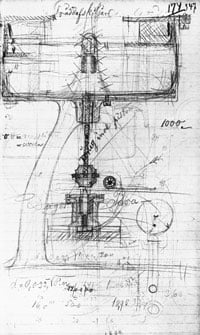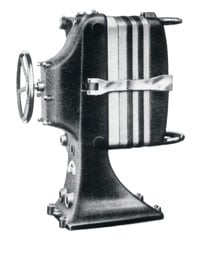History of Alfa Laval
Alfa Laval was founded in 1883. With the help of some of the most important milestones, you can follow Alfa Laval’s growth towards the large international group it has become today.
1845
Alfa Laval’s founder, Gustaf de Laval, is born in the province of Dalarna in Sweden.
1877
After reading an article in the German periodical, Milchzeitung, Gustaf de Laval starts to work on the development of a centrifugal separator.
1879
The first continuous separator is demonstrated in Stockholm. This separator has a capacity of 130 litres per hour.
1883
Gustaf de Laval and his partner, Oscar Lamm, establish the company AB Separator. The De Laval Cream Separator Co. is formed in the U.S. which is the start of a continuously growing international establishment.
1888
The first pumps are sold. They are used to pump skimmed milk from the centrifugal separator.
1889
The German inventor, Clemens von Bechtolsheim’s patent for conical metal discs is acquired. By using these so called Alfa-discs, the separator’s capacity is increased many times over.
1890
Alfa Laval introduces the world’s first continuous separator using the Alfa disc stack technology. The first continuous milk pasteurizer is introduced.
1898
The first yeast separator is installed in a customer’s production line.
1910
Gustaf de Laval begins to work on the design of a milking machine.
1913
Gustaf de Laval dies at the age of 67. During his lifetime, he acquires 92 Swedish patents and establishes 37 companies. His memorial is engraved with the inscription: “The Man of High Speed”.
1916
Alfa Laval sells the first separator for oil purification.
1919 – 1936
Subsidiaries are formed in Denmark, South Africa, Finland, Australia, New Zealand, Poland, Yugoslavia and Ireland.
1933
The world’s first hermetic separator is introduced by Alfa Laval at an exhibition in Berlin.
1938
Alfa-Laval introduces its first heat exchanger. Pontus Hytte, son of the famous Swedish painter Carl Larsson, moves the development and production of heat exchangers to Lund.
1951
Sales of the “self-cleaning” centrifugal separator and decanter centrifuges begins.
1958
The first automatic CIP (Cleaning-In-Place) system is installed in a Swedish dairy.
1961
The first sterilization processing system is installed in Italy. This marks a major breakthrough in the dairy and liquid food-processing sector.
1962
AB Rosenblad’s patents are acquired, bringing the spiral heat exchanger as well as a series of industrial plate designs into the possession of AB Separator.
1963
The company changes its name from AB Separator to Alfa-Laval AB. The name “Alfa” derives from the alpha discs and “Laval” from the founder of the company.
1965
The first large computerized control system is delivered to a dairy in Switzerland. This system makes it possible to supervise and control the entire plant.
1971
Alfa-Laval acquires a majority interest in the Danish company Lavrids Knudsens Maskinfabrik (LKM), marking Alfa-Laval’s establishment in the fluid handling business.
1976
This is a year of substantial investments. In Sweden, construction begins on a new manufacturing plant for marine separators in Tumba outside Stockholm. The Thermal Business Area in Lund starts construction of new offices and an international production centre for plate heat exchangers. In Spain, Alfa Laval expands its plants, offices and warehouses.
1981
Alfa Laval strengthens its foothold in Japan by increasing its holdings in the Japanese firm Nagase-Alfa to 70 per cent and by establishing Alfa Laval Service K.K. as a wholly-owned company.
1991
Tetra Pak, which provides packaging solutions to the food industry worldwide, and the Rausing family acquire Alfa Laval.
1993
Alfa Laval becomes an independent industrial group within the Tetra Laval Group. Liquid food processing activities are integrated with Tetra Pak’s business. Farm equipment and systems are reorganized into a new industrial group, Alfa Laval Agri.
1996
A new factory for heat exchangers, fluid handling equipment and modules for the food and beverage industry was opened in Kaliningrad outside of Moscow. The factory is one of the most modern in Russia.
1999
Alfa Laval launches an innovative oil treatment system for ships as well as the most advanced automated control of valves in the industry.
2000
The investment company Industri Kapital buys the Alfa Laval Group. Industri Kapital’s intention is to further develop Alfa Laval’s global leadership within its key technologies Separation, Heat Transfer and Fluid Handling, with the intention of listing the shares publicly within a five-year period.
2001
Major restructuring of Alfa Laval into market-oriented divisions and segments with distinct customer focus.
2002
Alfa Laval returns to the Stockholm Stock Exchange. The main strategy is to create profitable growth, both organically and through acquisitions, which in 2002 include two Danish companies; Danish Separation Systems A/S (DSS), a specialists in membrane filtration for the pharmaceutical and food industries, and the Toftejorg Group, the world’s leading supplier of advanced tank cleaning systems.
2003
AlfaNova, a major breakthrough in heat transfer, is launched. AlfaNova is a totally new type of plate heat exchanger, based on Alfa Laval’s patented method of brazing the plates, called AlfaFusion. AlfaNova’s extraordinary strengths in regard to temperatures, pressures and fatigue resistance open new and interesting possibilities in existing and future applications.
2004
Lars Renström is appointed new CEO and President of the Alfa Laval Group. He has a solid and successful record within Swedish industrial companies. Alfa Laval and Haldex, a multinational supplier of vehicle technology, form a jointly owned company, Alfdex AB, to supply jointly developed solutions for cleaning crankcase gases from diesel engines to meet increasingly stricter emission regulations.
2005
Packinox S.A. in France, a world leader in large, welded plate heat exchangers for oil and gas and refinery applications, is acquired. The company’s recognized competence will result in strengthening Alfa Laval within these fields.
2006
A very high demand in most of Alfa Laval’s end markets – primarily the energy and energy-related sectors – contributes to the increase in order intake by 30 per cent from 2005. Tetra Pak’s fruit concentrate unit is acquired, which means that Alfa Laval will penetrate this market through its own sales companies.
2007
Alfa Laval takes important steps towards becoming a world-leading provider of air heat exchangers by acquiring Netherlands-based Helpman and Finnish Fincoil, both leading European suppliers of air heat exchangers. Helpman's products are used for commerical refrigeration, for example in the sensitive logistic chain for food. Fincoil is particularly strong within industrial power cooling.
2010
Alfa Laval is an official partner to the Swedish pavillion at the World Expo in Shanghai: "Better City, Better Life".
2011
Alfa Laval acquires Aalborg Industries and two years later the Norwegian company Frank Mohn which further strengthens Alfa Laval’s presence within the marine and offshore markets.
2014
Alfa Laval opens its Test and Training centre in Aalborg, Denmark, for marine products and applications.
2016
Tom Erixon is appointed new CEO and President of the Alfa Laval Group.



